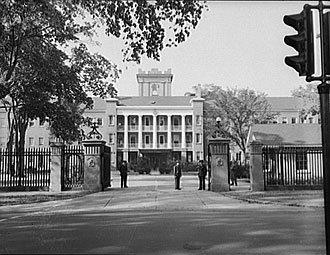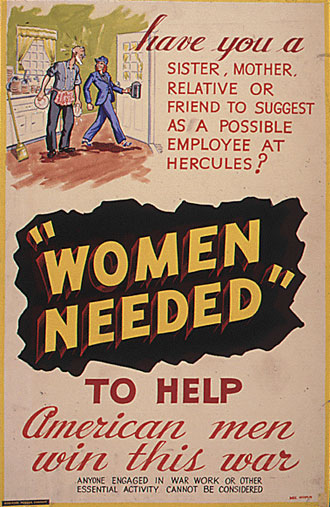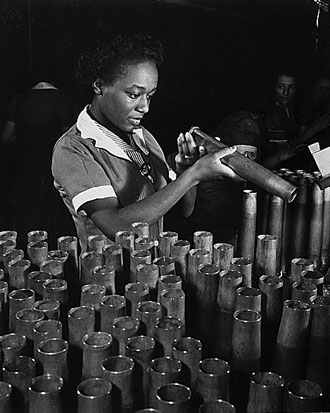




Advanced Search
Dress Up | 1st Person | African American Map | Now Read This | Magic Lens | Tool Videos | Architecture | e-Postcards | Chronologies
Dorothy Pryor - 1941-1945: Working at the Springfield Armory during World War IIDorothy supported the war effort by working as a shop checker at the Springfield Armory... Learn more about Dorothy Pryor: View a timeline of her life and listen to her full interview. Stories by this speaker

Guards stand at the gate to the Springield Armory’s administration building. The “Arsenal at Springfield” was established on a site chosen by General George Washington in 1777. It produced cartridges and gun carriages and stored weaponry during the American Revolution. Following the war it was the scene of violence during Shays’ Rebellion, when Massachusetts milita men fired upon anti-government Regulators attempting to commandeer the Arsenal building and its stores. The armory began making weapons in 1794. It continued to manufacture small firearms through the Civil War, including the famous Springfield Rifle. By World War II the Springfield Armory was the sole manufacturer of the semi-automatic M1 or “Garand Rifle” invented at the Armory by John Garand in 1934. The Defense Department closed the Springfield Armory in 1968. It is now a national historic site administered by the National Park Service. Prior to its closing, the Springfield Armory played a central role in the economic prosperity of its city, which since the late nineteenth century had been known as the “City of Homes”. The Springfield Armory has remained a constant in Dorothy Pryor’s life. She grew up two blocks from the Armory, and remembers roller skating near it, and attending gym class on its parade grounds. During World War II, she was employed by the Springfield Armory as a shop checker, or parts inspector. She considers herself to be “a different product of the Armory.” Alfred Palmer, “Gate of guns. Main entrance to the Administration building at an eastern armory, now turning out guns for the war program.” 1940, Library of Congress, Prints and Photographs Division, FSA/OWI Collection, Reproduction Number LC-USE6- D-000136 [P+P]. 
Hercules, Inc. which produced naval stores and explosives during the war, advertised for women workers “to help American men win this war.” One of the ways in which American women supported the war effort was by entering the workforce. As able American men went to war, women were asked to step in to fill the gap, and to take on either war factory work, or other jobs necessary to maintaining the home front. Many of the women who did war factory work were, like Dorothy, young and unmarried. But as the war progressed, mothers of even very young children were asked to take on jobs outside of the home. The number of women added to the workforce was significant. Prior to the war there had been 12 million women in the American workforce. That number increased to 18 million by the end of World War II. It is hard to imagine the many ways in which the lives of these women were changed by their wartime experiences. Frieda Lorretta Calvano, who worked in production for Dupont in New Jersey and as a draftsman for Sperry Gyroscope in Brooklyn, New York, believed that, In spite of our nation’s circumstances, it was one of the most interesting parts of my life, showing me things I never knew existed. It taught me that if there’s something you think you should do, then do it. How did the war change my life? You couldn’t even go into it, but it did give me a better value of life. When victory was won we went crazy; the joy was crazy, and crying...1 Oh, and my brother and boyfriend overseas? They both made it back safely. I married my boyfriend soon thereafter and started a family. Heleyn A. Potter, who a welder and riveter at the Curtis Wright Aircraft Company in Saint Louis, Missouri, during the war described those experiences this way: “War changes everything. I was a welder and now a riveter in an all-woman work force. Five years earlier, I was studying ballet, planning to become a ballerina. As we supported the War Effort, the collective soul of women changed.”2 “Have you a sister, mother, relative or friend to suggest as a possible employee at Hercules? "Women needed" to help American men win this war.”, ca. 1942 - ca. 1943 National Archives, ARC Identifier 535422. 1Memoir of Frieda Loretta Calvano http://www.nps.gov/pwro/collection/website/frieda.htm Retrieved March 26, 2010. 2Memoir of Heleyn A. Potter, http://www.nps.gov/pwro/collection/website/helyn.htm Retrieved March 26, 2010. 
"Bertha Stallworth, age 21, shown inspecting end of 40mm artillery cartridge case at Frankford Arsenal." Dorothy was a college student attending Fisk University during the war. On school breaks she supported the war effort by working at the Springfield Armory. Like Bertha Stallworth (above), Dorothy was a “shop checker,” inspecting finished work. She remembers, And one of the loveliest experiences with…came …the summer of forty…four, I guess, yeah, the summer, the summer when I was going back for my senior year. This Armenian lady, Ida Garib, I…I still remember her name, who was a fantastic worker – I mean …she could put out gun parts – I've forgotten what…what the little part was she was making – but she…she set the standard for everybody else in the foundry. She could really go great guns, sitting at that, you know…and I was accurate and…She had been watching me and whatnot, and when I got ready to go to school, she had taken up quiet…unbeknownst to me, a collection – and was…I remember it was 67 dollars, but in 1944, 67 dollars was like 670, you know, or more – to help with my books. And I'll never forget it. She just…she wished me well, and got that for me. I…I think I'd…might of…I think she let go of the machine long enough to hug me. And I never forg…I never forgot that. She was so concerned, so impressed with my energy and my efficiency, and my concentration on the work. But, you know, most of the people were…were... women. There were a few …fellows working there, but …they were…they were there because they…their physical disabilities kept them out of the service. So, it was…it was great. It was a lovely experience. Photo of Bertha Stallworth, , ca. 1941 - ca. 1945, National Archives, ARC Identifier 535805. Story Clip #1:"I'm a different product of the Armory" Wait for each file to download, then click the arrow to play the audio. But I grew up near the Armory. It was just ironic that, 'cause I have...I've got a little pamphlet I,m try...trying to finish writing, when I talk about being a different project...product of the Armory. 'Cause I used to have...we used to...when I was ...growing up when we were...when I was in junior and senior high school, ...in the spring and the early fall, the public school kids at Classical Junior - see I went to Classical Junior - we used to have our gym classes on the parade ground. And I learned to hate field hockey, because in those days, they didn't have any equipment, and I got hit in the shins - Oh, that hurts! - [both laugh] with a hockey stick. Oy! I can still remember that. And then...but I learned to love soccer, 'cause I liked to kick the ball. And... you know. And I used to skate. I told you I used to roller skate as a kid down that hill. I loved it. So I...I'm a different product of the Armory. But I enjoy... Q: A different product of the Armory. Story Clip #2:During summer breaks Dorothy becomes a shop checker at the Springfield Armory Q: I would like to ask about. ...I know you came home to Springfield... Mm hmm... Q: ...in the summers, and I'll get to that, shortly... Mm hmm... Q: ...but I...I want to ask you about traveling, because that was during the war. You graduated from high school in 1941... Mm hmm... Q: ...and then you went off to Fisk University and you came home in the summers. Was that a hardship for you? ...Well... I managed to get enough money, I guess. I did...I was...I guess you'd call it student ... employment on campus, and I just saved my money so I could go back an forth on the train, you know. Um, I had to work. That's was one of the reasons why it was delightful to work at the Armory. That's what I did. I kept my grades up so I would have my scholarships, and I made the rest of the money working at the Armory...um...on split shifts whatever...wherever they needed me. And, you know, that was...there wasn't any such thing as student aid. [laughing] You, you worked and then you kept your grades up. And that's how I stayed there. Q: You aided yourself. Yeah, well really. And, it was good experience. A marvelous experience.... Q: Now, what did you do in the...talk about your job at the Armory. I was a...I was a shop checker. I was a relief checker for the ...production of the people working on the machines there, and uh, I...During the time I was there, you know, I worked whenever they needed me. Sometimes...and since I lived just two blocks away from the Armory, I sometimes had to work the eleven to seven shift. But in the early 40s, like that, there wasn't that much danger on the streets. I couldn't do it now. But I was only two blocks away. I walked, and I suspect my mother and father prayed, too, because they weren't, you know...they weren't fanat...religious fanatics, but they were both very, very strong Christians, and they just...they...they trusted the Lord to protect me. And ...it wasn't a dangerous time. It was, you know...And I didn't mind doing my [part]... Story Clip #3:The Springfield Armory: "It was a lovely experience" Q: What I would like to know is, what it was like, first being a woman working in a place where I presume they had mostly, probably before that time, had had all men. Mm hmm. Q: And also what it was like to be... ...black, there... Q: ...an African-American woman, and what that was like, and were you the only woman? Were you the only black person? Oh no, no. Actually, one thing that the war period did, was to make sure that everybody who could work and wanted to work, could. Uh and...it...color and gender became...race and gender became much less important than what you could do for the...for the war effort? And I, I know that our black veterans discovered that...our black soldiers discovered that. 'Cause you know, bullet has...a bullet has no...no racial connotation. And so, when you were working for the...working for the good of the country, you worked, you know. And there were more women, of course, than men. . The only black man that I knew then - he's still a friend of mine; he still lives in the area - was Miles Hatchet, Senior, who, I think had...had physical disability that kept him from...from being ...drafted. So he worked at the Armory, too. That's where I met him, actually. But ...you know, it was mostly women, 'cause men were...men were off to war. And your...I guess I was blessed, because having been at Classical Junior and Senior where I was very often the only black student in my class, and having learned as my...even...even from my mother, learned how to be appreciative of people, not worry about race, particularly, because my grades took me out of the racial situation and put me in top classes with top teachers who, you know, were just amazed at what I could do, and...and encouraged me. So you know, hey, whatever. So, ...when I was at the Armory, I...I knew how to take care of my job. For one thing, it was how I was going to college. And for another thing, I liked people and I wasn't...wasn't uncomfortable about people of different races. And ?course, I rem...and I had learned also, that you do...you do your job and do it well. So you don't have to worry about it. I learned to be truthful. I used to tell my students, I don't lie. And they said, You don't lie? And I said, No, because you have to remember...if you lie, you have to remember what you looked like, exactly how you said it, and how you held your mouth, the whole... I said, I am too lazy to lie. [laughing] I just simply tell the truth and... What is it? Tell the truth and shame the devil? Well, I loved what I did. I was...I knew it was getting me back and forth to school, so I just went. And it was mostly women, 'cause if a fellow was able-bodied, he was in the service. So I...I, you know...I checked people's ...production, you know, and I tried...I was bright enough to count and to be honest, and whatnot. And one of the loveliest experiences with...came the year, ...the summer of forty...four, I guess, yeah, the summer, the summer when I was going back for my senior year. This Armenian lady, Ida Garib, I...I still remember her name, who was a fantastic worker - I mean she had a...she could put out gun parts - I've forgotten what...what the little part was she was making - but she...she set the standard for everybody else in the foundry. She could really go great guns, sitting at that, you know...and I was accurate and...She had been watching me and whatnot, and when I got ready to go to school, she had taken up quiet...unbeknownst to me, a collection - and was...I remember it was 67 dollars, but in 1944, 67 dollars was like 670, you know, or more - to help with my books. And I'll never forget it. She just...she wished me well, and got that for me. I...I think I'd...might of...I think she let go of the machine long enough to hug me. And I never forg...I never forgot that. She was so concerned, so impressed with my energy and my efficiency, and my concentration on the work. But, you know, most of the people were...were... women. There were a few ...fellows working there, but ...they were...they were there because they...their physical disabilities kept them out of the service. So, it was...it was great. It was a lovely experience. Related ResourcesThe following source file was not found: ebdav/centuries/html/resource/pryor1941.html
|
| |
Home | Online
Collection | Things To Do | Turns
Exhibit | Classroom | Chronologies | My
Collection
About This Site | Site
Index | Site Search | Feedback